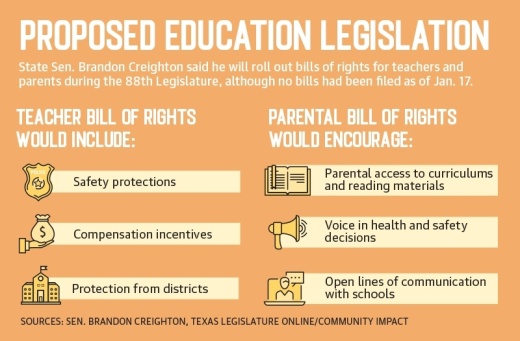Lawmakers will have an unprecedented amount of money to spend as they create the state’s next budget: $188.2 billion. This is largely thanks to high sales tax revenue, spikes in energy prices and overall economic growth in recent years, according to Texas Comptroller Glenn Hegar.
This is a 26.3% increase in general revenue funds compared to the previous budget cycle, Hegar said during the presentation of his biennial revenue estimate Jan. 9.
Local leaders, such as state Sen. Lois Kolkhorst, R-Brenham, have emphasized public education initiatives as well as topics such as property taxes.
“I am confident that the Texas Legislature will make both funding education and offering property tax relief a top priority in the state’s policy and budget agendas, and I look forward to working closely with the educators in my district on the details,” Kolkhorst said in a Nov. 28 statement.
Eye on education
Both lawmakers and policy advocates said they would like to see changes made to the state’s public education system.
State Sen. Brandon Creighton, R-Conroe, chairs the Senate Committee on Education. Although Creighton had not filed billsas of press time Jan. 17, he said in a Dec. 8 interview he is continuing to work on a Parental Bill of Rights and a Teacher Bill of Rights to file in February.
In a September news release, Creighton said the reforms in the Teacher Bill of Rights would include safety protections, compensation incentives and protection from retaliation from their districts. He said the Parental Bill of Rights would increase transparency and access and “empower parents as active participants in their children’s education.”
Likewise, state Rep. Will Metcalf, R-Conroe, said he is focused on school safety and revising standardized testing.
“I am also extremely passionate about reigning in high-stakes [State of Texas Assessments of Academic Readiness] testing,” he said in a statement to Community Impact. “While I can understand the intention behind standardized testing, we as a state must find a better way to measure student achievement, academic readiness and district progress.”
However, officials with Conroe and Montgomery ISDs said their priority for the 88th legislative session is funding.
"Conroe ISD works closely with state legislators in advocating for funding to meet our rapidly growing district’s needs,” CISD spokesperson Sarah Blakelock said. “The current funding formula is a main topic of conversation. We feel it is more reasonable to be funded on enrollment instead of daily attendance.”
Blakelock said a formula change would also allow for raises for employees.
MISD Superintendent Heath Morrison said district leaders also believe a formula change is necessary to correct inequitable funding that resulted from a tax rate cap the state imposed in 2006.
He also said data shows the gap between funding per student in MISD versus the state average is increasing. According to financial reports from the Texas Education Agency, the gap in general funding per student grew 34.92% between MISD and the state from 2016-17 to 2020-21, a difference of $1,159 per student in 2020-21.
“It’s not just that there’s a gap—there’s been a gap for a long time. It’s that the gap is getting bigger and bigger and bigger,” Morrison said in an interview. “Even if we’re increasing [funding], the state average is increasing at such an accelerated rate, every time a surrounding school district does something, we have less revenue to compete.”
Likewise, Bob Popinski, senior director of policy with Raise Your Hand Texas—an educational policy organization—said the state is around $4,000 below the national average in per-student spending.
“With 5.5 million kids on a $70 billion system, it’s tough to maneuver a school finance bill through the legislative process,” he said. “We’ll continue to inch forward until we meet those goals of being ... at least average in per-pupil spending when it comes to our students, if not above that.”
Tackling taxes
Several local lawmakers have also filed bills aimed at lowering the amount property value appraisals can rise each year. Previous Community Impact reporting showed the average market property value in Montgomery County jumped 29.8% from 2021 to 2022.
Creighton said at an October Greater East Montgomery County Chamber of Commerce luncheon he would like to see the cap on the annual appraised value increase for property tax purposes lowered this session.
“We need a supermajority in the Legislature to lower the appraisal cap. It’s at 10[%], but we need it somewhere down closer to 3[%],” he said.
Locally, lawmakers have filed bills related to property value appraisals. House Bill 335—filed by state Rep. Cecil Bell, R-Magnolia—and Senate Bill 152—filed by Kolkhorst—propose lowering the appraisal cap to 5%.
Additionally, House bills 808, 809 and 810—filed by Metcalf—would require chief appraisers, board of directors members and appraisal review board members to be elected instead of appointed.
“One of my top priorities heading into the 88th legislative session is appraisal reform,” Metcalf said in a statement. “We must combat the appraisal side of the formula this session and lower appraisal caps on homesteads, put caps on commercial property, and bring much needed accountability and transparency to appraisal districts by electing the chief appraiser, board of directors and appraisal review boards.”
Cassandra Jenkins, Kylee Hauter, Wesley Gardner and Emily Lincke contributed to this report.







